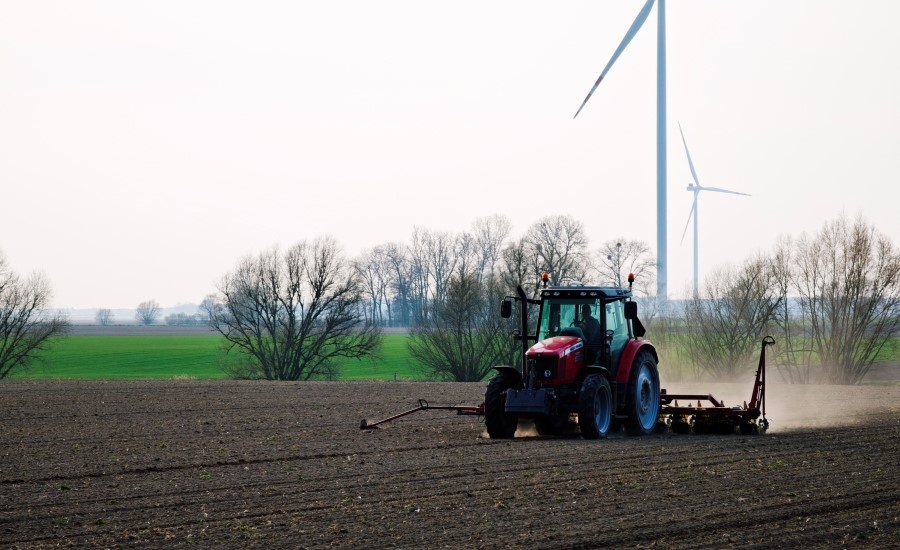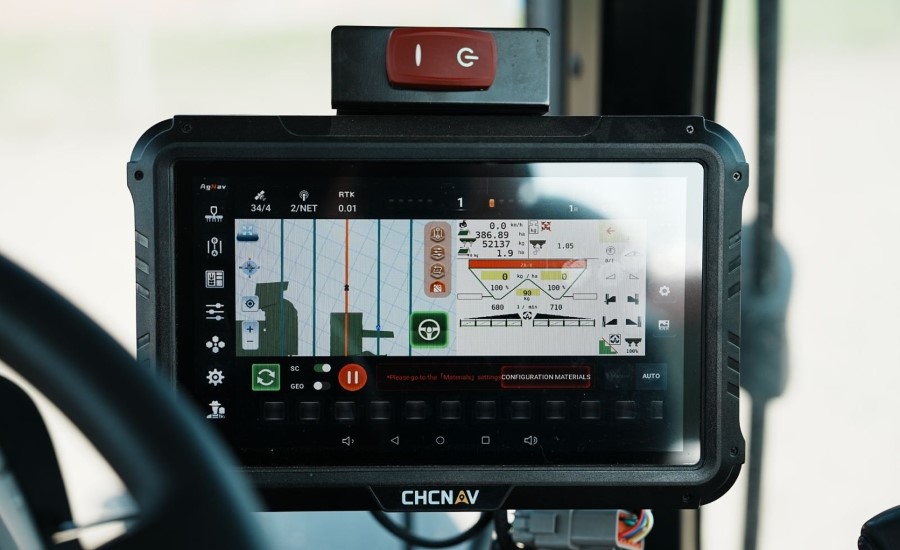Modern agriculture is undergoing a steady transformation. Skilled labor shortages, fluctuating weather conditions,
and the pressure to increase yield with fewer resources are accelerating the adoption of precision technologies across
the farming industry.
Among these, the auto-steering system stands out as a central tool, reshaping how tractors operate in the field.
Farmers and agricultural enterprises are increasingly integrating automated guidance systems not only for field
consistency but also to improve efficiency in tasks such as row crop management, tillage, spraying, and other
operations that demand precision across large tracts of land.
For people who know little about auto-steer systems for tractors, CHCNAV will guide you through all key aspects, exploring how they can
bring your farming practices up to the next level.

What Are Auto-steering Systems for Tractors?
Auto-steering systems are automated guidance technologies designed to control a tractor's movement with minimal input
from the operator. These systems use satellite signals, onboard sensors, and advanced software to maintain precise
alignment across rows or tracks. In doing so, they help maximize efficiency, reduce input waste, lower operator
fatigue, and maintain consistent field coverage with high accuracy.
Key Components of Tractor Auto-steering Systems
Auto-steering systems consist of the following key components:
GNSS Antennas and Receivers
GNSS antennas and receivers are responsible for capturing satellite signals and determining the tractor's location
with high precision. With the support of advanced correction services, GNSS antennas and receivers enable the system
to achieve consistent, cm-level accuracy that is essential for row spacing, boundary adherence, and long-term
repeatability in fieldwork.

Control Console or Tablet
The control console or tablet, installed inside the tractor cab, gives the operator a centralized point of
interaction with the system. From field mapping and guidance line selection to real-time tracking and system
calibration, this interface manages all core functions of the auto-steering setup. Most modern units support touch
operation, remote updates, and seamless integration with cloud-based farm management systems.
Steering Actuator
The steering actuator is generally the electric motor component that provides the torque to turn the steering
wheel. It is the part that physically moves the steering mechanism under electronic control. In electric auto-steering
systems, this actuator is integrated into or attached to the steering wheel assembly to automate steering inputs.
Sensors
These include angle sensors to measure the rotational movement of tires or steering components, speed sensors, and
other environmental sensors. The combination of sensor feedback and satellite input allows the auto-steering system to
maintain path accuracy even when the terrain changes or the surface becomes unstable.
Connectivity Modules
Connectivity modules enable communication between the GNSS receiver, control console, steering actuator, and
sometimes external farm management platforms. They support data transfer and integration with implements via standards
like ISOBUS, enhancing interoperability and operational efficiency.
Learn more about ISOBUS: What Is ISOBUS in
Precision Agriculture?
Cabling and Integration Hardware
Robust cabling and integration hardware link all system components while providing insulation from vibration, dust,
moisture, and temperature extremes. Proper cabling ensures that data signals and power supply remain uninterrupted
during prolonged field use. High-quality harnesses, connectors, and interface units contribute significantly to
overall system reliability and ease of maintenance.
How Do Tractor Auto-steering Systems Work?
The operation of a tractor auto-steering system is driven by a coordinated interaction between positioning
technology, onboard sensors, control software, and mechanical steering components. Here is how everything unfolds:
Establish the Guidance Line
Before the tractor starts moving, the operator sets up a guidance line using the control console. This can be a
straight line, curve, or pivot, depending on the field geometry. Field borders are usually mapped in advance or loaded
from past records.
Real-Time Position Tracking
As the tractor begins its path, the GNSS antenna continuously calculates the exact position. Paired with sensor data,
the system monitors the vehicle's heading, speed, and lateral displacement from the ideal path.

Deviation Calculation
Any deviation from the intended line is instantly detected. The control system calculates how far off the tractor is
and how sharply it needs to steer to get back on track.
Steering Command Execution
Based on the calculated deviation, the actuator adjusts the steering wheel. These corrections are typically smooth
and constant to avoid abrupt movements that could disrupt fieldwork.
Continuous Adjustment and Correction
The cycle of sensing, calculating, and steering occurs in real time. Updates can happen within milliseconds. As the
tractor moves, it remains centered along the guidance line, even when terrain or speed changes.
Importance of Corrective Signals for Accuracy
Corrective signals play a major role in ensuring the positional accuracy of tractor auto-steering systems. Here is
why these systems are important:
Understanding GNSS limitations
Basic GNSS services generally achieve meter-level accuracy, and their accuracy can be impacted by many factors, such
as satellite geometry, atmospheric conditions, or clock errors. While these are acceptable for car navigation, they
fall short in field operations where row overlap or misalignment can reduce productivity and crop quality.
Correction Services
To overcome the inherent limitations of standalone GNSS signals, auto-steer systems depend on correction services
that enhance positional accuracy and ensure the consistency required for modern agricultural operations.
Among different correction techniques, RTK (Real-Time Kinematic) is common for high-precision agriculture. It uses a
fixed base station to send real-time corrections to the tractor, achieving an accuracy of up to 2.5 cm. Systems with
RTK often use a radio link or cellular modem to receive these corrections.
You may run RTK with your own base station or with a CORS (Continuously Operating Reference Stations) network. The
latter is often more convenient and cost-effective, as many countries operate CORS networks that allow farmers to use
corrections without installing a base station on-site.
Furthermore, PPP (Precise Point Positioning) is a correction technique that requires no local base station. However,
it tends to have a slower convergence time and is generally used in applications where sub-meter accuracy is
sufficient. Nevertheless, paid PPP services are capable of providing higher positioning accuracy and faster
convergence times.
Learn more about RTK and PPP:
How Does RTK Work for
Precision Agriculture?
What
Is Precise Point Positioning in Precision Farming?
Benefits of Implementing Tractor Auto-steering Systems
Considering their upfront costs, are there any benefits to implementing tractor auto-steering systems? The answer is
a resounding yes. Here are some of them.
Increased Efficiency
Auto-steering systems guide tractors along precise, repeatable paths, reducing overlap and avoiding missed spots in
the field. This leads to more uniform operations, improved fuel economy, and better time management, especially during
long or complex passes.
Reduced Operator Fatigue
By handling repetitive steering tasks, these systems help operators reduce physical strain.
Optimized Resource Management
Accurate steering ensures inputs like seed, fertilizer, and crop protection are applied at the right rate and
spacing. This reduces waste, avoids overlaps or gaps, and supports both cost control and environmental sustainability.
Improved Yield and Profitability
Consistent application and row spacing improve crop uniformity, resulting in efficient use of field space. Over time,
this leads to stronger yields and improved profitability, particularly in high-input operations.
Enhanced Data Collection and Analysis
Many systems record field activity in real time. This data can be used to evaluate performance, monitor input
accuracy, and support precision strategies. When paired with farm software, it also improves planning, documentation,
and decision-making.
Check CHCNAV's Auto-Steering Systems
CHCNAV offers a range of auto-steering solutions tailored to meet the precision demands of modern agriculture.
Our systems combine GNSS-based positioning with advanced onboard control to deliver 2.5 cm-level accuracy across
diverse terrain and operating conditions. Key strengths of these solutions include support for various correction
services such as RTK and PPP, along with real-time steering performance at speeds as fast as 30 km/h.
Designed for both new and retrofitted farm machinery, the systems are known for their ease of integration, wide
compatibility with vehicle brands, and user-friendly interfaces.
Enhanced features like terrain compensation, multiple guidance patterns, remote connectivity, and ISOBUS compliance
ensure operators maintain precise control during seeding, spraying, tillage, and harvesting.
With flexible connectivity and robust construction, our product lineup serves farms looking to scale productivity
without compromising accuracy or comfort.
Wrapping Up
Tractor auto-steering systems have become essential for farms aiming to increase precision, reduce waste, and
streamline daily operations. CHCNAV stands out with a range of solutions built for accuracy, ease of use, and
adaptability across different machinery types.
Our commitment to performance and innovation makes us a solid choice for farms looking to upgrade their farming
capabilities. Looking for more details? Click here to get
in touch with us.
____
About CHC Navigation
CHC Navigation (CHCNAV) develops advanced mapping, navigation and positioning solutions designed to increase productivity and efficiency. Serving industries such as geospatial, agriculture, construction and autonomy, CHCNAV delivers innovative technologies that empower professionals and drive industry advancement. With a global presence spanning over 140 countries and a team of more than 2,000 professionals, CHC Navigation is recognized as a leader in the geospatial industry and beyond. For more information about CHC Navigation [Huace:300627.SZ], please visit: www.chcnav.com





